 Image search results - "ibaraki" Image search results - "ibaraki" |

Welcome to IbarakiTrain platform of Kairakuen Station.
|
|

Higashi Mito Station (on the way to Oarai)
|
|

Train platform of Kairakuen Station
|
|

Oarai StationShort ride from Mito Station.
|
|

Train platform of Kairakuen Station
|
|

Observation tower at the beach and a symbol of Oarai
|
|

Plum Blossom Queen at Kairakuen StationShe was passing out maps of the garden. It was a nice touch to see two of these kimono beauties greeting us.
|
|

Ferry port (service to Otaru, Hokkaido)
|
|

Plum Blossom Queen
|
|

Sign saying Oarai is famous for noren curtains.
|
|

Entrance to garden via Tokiwa Shrine. One of Japan's three most famous gardens, Kairakuen is especially noted for thousands of plum blossom trees which bloom in Feb. and March.One of Japan's three most famous gardens, Kairakuen is especially noted for thousands of plum blossom trees which bloom in Feb. and March.
|
|

Wave breakers
|
|

Tokiwa Shrine, MitoDedicated to Lord Mitsukuni Tokugawa, the second lord of Mito, and Nariaki Tokugawa, the ninth lord of Mito and the one who built Kairakuen Garden.
|
|

Resort hotel
|
|

Bonsai plum treesI bought one of these once and the flowers smelled good before they withred away. The tree also died soon afterward.
|
|
|

Crowd at Higashi-mon East GateThis was the defacto main gate and most crowded since it is closest to the train station.
|
|

The beach
|
|

Map of Kairakuen, a garden built in 1841 by Tokugawa Nariaki (1800-1860), the ninth Lord of Mito. It is one of Japan's three most famous gardens.
|
|

Oarai Isosaki Shrine's giant torii
|
|

Pinickers
|
|

Oarai Isosaki Shrine's giant torii
|
|

Plum blossom-viewing picnickers
|
|

Oarai town
|
|

Red and white plum blossoms
|
|

Oarai Isosaki Shrine torii at sea
|
|
|

Oarai Isosaki Shrine torii at sea
|
|

White plum blossoms, the most common variety, and with the sweetest aroma.
|
|

Oarai Isosaki Shrine torii at sea
|
|
|

Torii at sea
|
|

Osaka-zuki red plum blossoms 大盃Osaka-zuki
大盃
|
|

Shoreline
|
|

Plum tree grove, about a week too early.
|
|

Isosaki Shrine torii as seen from the beach
|
|

Fantastically-shaped plum tree
|
|

Isosaki Shrine's second giant torii
|
|

Konan Shomu plum blossom 江南所無Prunus mume Kounanshomu
|
|

Isosaki Shrine torii
|
|

Plum Blossom Queens in Kairakuen, Mito
|
|

Isosaki Shrine torii
|
|

Plum Blossom Queens in Kairakuen, Mito
|
|

Isosaki Shrine
|
|
|
|

Giant votive tablet (2006 is the year of the dog)
|
|

Plum trees and Lake Senba
|
|

Shrine
|
|

Plum trees and Lake Senba
|
|

Koma-inu lion dog and lanterns
|
|

Plum trees and Lake Senba
|
|

Boat museum within the shrine grounds
|
|
|
|

Path from shrine
|
|

Torano-o plum blossom (Tiger's Tail) 虎の尾
|
|

Seafood restaurants
|
|

Pine trees and plum trees
|
|

Seafood restaurants
|
|

Plum tree grove
|
|

Anko seafood soup (miso-based)
|
|

Plum tree and train
|
|

Fresh oysters
|
|

Monument proclaiming Kairakuen as one of Ibaraki's 100 Best Sights
|
|

Baby scallops
|
|

Poem monument
|
|

Ika squid
|
|
|

Dried fish
|
|

Closeup of white plum blossom
|
|

Train back to Mito.
|
|

Closeup of red plum blossom
|
|
|
|
|
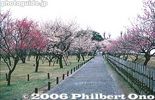
Plum grove
|
|

Path to natural spring
|
|

Natural spring (cold water)
|
|

Bamboo grovePine trees, bamboo, and plum blossoms are called Shochikubai in Japanese. This trio of trees is most famous.
|
|

Omote-mon GateThis supposed to be the front gate.
|
|

Kobuntei Villa has exquisite Japanese-style paintings on paper sliding doors. Kobuntei was damaged by the March 2011 Tohoku earthquake and was closed until early 2012 for repairs.
|
|

Kobuntei Villa was originally built in 1842 by Tokugawa Nariaki (1800-1860), the ninth Lord of Mito. It was his summer villa.
|
|

Kobuntei Villa, fusuma sliding door with painting of plum trees
|
|

Kobuntei Villa, fusuma sliding door with painting of azalea
|
|

Kobuntei Villa, fusuma sliding door with painting of fall leaves
|
|

Kobuntei Villa
|
|

Kobuntei Villa
|
|

Kobuntei Villa
|
|

Kobuntei Villa, fusuma sliding door with painting of maple leaves
|
|

Kobuntei Villa
|
|

Kobuntei Villa
|
|

Kobuntei Villa
|
|

Kobuntei Villa
|
|

Kobuntei Villa
|
|

Kobuntei Villa, fusuma sliding door with painting of cherry blossoms
|
|

Kobuntei Villa
|
|

Cherry Blossom Room, Kobuntei Villa
|
|

Kobuntei Villa
|
|

Kobuntei Villa
|
|

Kobuntei Villa
|
|

Kobuntei suffered quite a bit of damage during the big earthquake on March 11, 2011. Repairs have started in Sept. 2011, and they hope to reopen the Kobuntei by Feb. 2012.
|
|
|
|
|
|
|
|

View from the top floor of Kobuntei Villa
|
|

View from the top floor of Kobuntei Villa
|
|

View from the top floor of Kobuntei Villa
|
|

View from the top floor of Kobuntei Villa
|
|

Inside the top floor of Kobuntei Villa
|
|

Inside the top floor of Kobuntei Villa
|
|

Balcony on the top floor of Kobuntei Villa
|
|
|
|
|

Kobuntei Villa
|
|

Kobuntei Villa
|
|

Kobuntei Villa
|
|

Natto fermented beans
|
|

Kairakuen StationThis station, right before Mito Station, is open only during major flower seasons of Kairakuen.
|
|

Hitachi-Otsu Ofune Matsuri fishing boat festival is Kita-Ibaraki's biggest festival, held only only once every five years on May 2 and 3 as the grand spring festival of Sawawachigi Shrine (佐波波地祇神社) in Otsu-cho, Kita-Ibaraki, Ibaraki PreHeld by local fishermen to pray for abundant fish and maritime safety. These photos were taken on May 3, 2019.
|
|

Unique Shinto festival where they drag a sacred fishing boat across land instead of water. The boat has no wheels. All other boat festivals have the boat sailing on water, but not this one.
|
|

On the May 2 festival eve, the boat is pulled from east to west along 1,200 meters in the center of town without the portable shrine aboard.
|
|

On the May 3 main festival day, the boat is dragged along the same route west to east with the portable shrine and shrine priests aboard.This boat is here at the start point on May 3, 2019.
|
|

White ropes to pull the boat on the road.
|
|

The bow has this shed for the portable shrine to be loaded on. Festival was designated as a National Important Intangible Folk Cultural Property (重要無形民俗文化財) in 2017.
|
|

Boat is 15 meters long, 4 meters wide, and weighs 5 tons. It becomes 2 tons heavier when the portable shrine (1 ton) and crew and musicians board.
|
|

The ofune wooden fishing boat is painted with local fish.
|
|

My video of Kita-Ibaraki's Ofune Matsuri boat festival.
|
|

Back of ofune boat.
|
|

This festival was originally a portable shrine procession on the sea via boat going around the bay. But the boat's start point was filled in, so the boat procession was then held on land instead since 200 years ago.
|
|

The festival started to be held every 5 years from 1975. The boat has to be repaired after each festival and the money could not be secured more often than every 5 years.The boat is normally displayed at a fishing museum named Yo-soro (よう・そろー) in Kita-Ibaraki.
|
|

The festival used to be held by local fishermen, Now held by Hitachi-Otsu Ofune Matsuri Preservation Society (常陸大津の御船祭保存会) with most of the men being fishermen or their descendants.
|
|

Paitning of a monkfish, a delicacy of Kita-Ibaraki.
|
|

The boat rests on wooden pallets called "soroban." It is dragged on a bed of soroban pallets.
|
|
|

The festival originally used an actual fishing boat. But now this wooden boat was built especially for the festival.
|
|

Sardines
|
|

On May 3 from morning, they parade the mikoshi portable shrine bearing Sawawachigi Shrine's god for maritime safety.
|
|
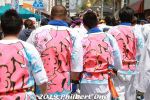
The festival participants belong to different fishermen's groups indicated by their shirt. They are from a group called Fudo-maru.
|
|

Thank You Club
|
|

This was the first Ofune Matsuri to be held in the new era of Reiwa.
|
|

Group photos in front of the boat.
|
|

Removing in the boat railingsbefore people boarded.
|
|

Most boat musicians are local kids.
|
|
|

Boat musicians and crew board the boat via ladder.
|
|

Looks like the boat captain.
|
|

Boat crew waiting for the portable shrine to be loaded on the boat, which then becomes a "sacred boat."
|
|
|

After being paraded around town all morning, the portable shrine arrives near the boat.
|
|

After being paraded around town all morning, the portable shrine arrives near the boat.
|
|

The boat crew welcome the portable shrine before it is loaded aboard.
|
|
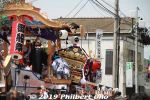
The portable shrine is loaded on the boat.
|
|

Ahead of the boat, wooden pallets called "soroban" are laid on the road for the boat to be dragged on.
|
|

They use about 100 soroban wooden pallets (ソロバン) made of Japanese oak tree, a hard wood. Each weighs 20 kg.
|
|

Before dragging the boat, they violently rock the boat side to side.
|
|

Boat is pulled by a 200-meter white rope, 7 cm thick. About 200 to 300 people pull the boat.
|
|
|
|

When dragging the boat, the men have to run over the wooden pallets and take care not to trip and fall.
|
|

They drag the boat 20 meters at a time. After each drag, they have to move and place the pallets ahead of the boat. The route is 1,200 meters long, and it takes 5 hours to reach the end.
|
|

Dragging the boat over the wooden pallets.
|
|

Ofune being dragged over wooden pallets.
|
|

Pallets are ready for the next drag.
|
|

There are men on both sides of the boat who rock the boat before the drag. When the boat moves, they hang on to the boat.
|
|
|

After the drag, they pick up the pallets and lay them in front of the boat on the road ahead.
|
|
|
|

Narrow streets make it crowded.
|
|
|
|

The boat hull has small center ridges that keep it standing upright. It's also designed not to topple over when rocked.
|
|

Three shrine priests are among the 40 people onboard. It's pretty rough to be rocked often. Motion sickness is possible.
|
|

The boat is tilted to one side when it is dragged. It creates less friction and makes it easier to drag.
|
|

Picking up the pallets.
|
|
|
|

The friction between the boat hull and pallets makes it smoke each time the boat is dragged. The pallets are scorched.
|
|

The route has one 90-degree corner where the boat is turned. This is a festival highlight and many people crowd this corner.
|
|

They turn the boat by dragging the stern of the boat. They had a rope tied to the rear part of the boat.
|
|

Turning the boat 90 degrees.
|
|

They turned the boat 90 degrees in one drag.
|
|

Getting ready for the rest of the straight route.
|
|
|

This corner is the most crowded spot. Many people leave after seeing this corner turn.
|
|

Shuttle bus back to JR Otsuko Station. Shuttle bus stop was near the start point a few hundred meters from the corner.
|
|

JR Otsuko Station
|
|

JR Otsuko Station has its entrance modeled after the Rokkakudo Pavilion on the Izura Coast.
|
|

JR Otsuko Station platform.
|
|

JR Otsuko Station platform.
|
|

Kita-Ibaraki is a small, coastal city (pop. 42,000) with these picturesque cliffs of the Izura Coast (五浦海岸). Famous art scholar Okakura Tenshin (1863–1913 岡倉天心) found this scenic place to be a great inspiration for artists and moved here
|
|

The small red pavilion is Izura Rokkakudo (五浦六角堂), the symbol of Kita-Ibaraki. Izura Rokkakudo was originally designed and built in 1905 by artist Okakura Tenshin (岡倉天心) as part of his residence. His house is on the left..
|
|

In Kita-Ibaraki, Tenshin used Rokkakudo to listen to ocean waves and gaze at the scenery. On March 11, 2011, it was washed away by the tsunami, but it was rebuilt in 2012.
|
|

Izura Rokkakudo (五浦六角堂) is now being maintained by Ibaraki University and it continues to be a sacred spot for Japanese artists.
|
|
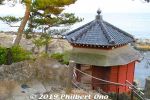
For a small admission fee, you can go down a path to see the Rokkakudo. (五浦六角堂).
|
|
|

The glass windows were made in the UK.
|
|
|

Must've been mesmerizing to pass time here. A place to attain artistic enlightenment.
|
|

You cannot enter the Rokkakudo, but you can see inside through the glass windows made in the UK. There's supposed to be tatami mats inside.
|
|
|

About Rokkakudo.
|
|

Scenery around Rokkakudo.
|
|

Scenery in front of Rokkakudo.
|
|
|

Artist-inspiring scenery around Rokkakudo, Kita-Ibaraki.
|
|

Tenshin's home on the Izura Coast, near the Rokkakudo Pavilion.
|
|

Tenshin's home on the Izura Coast, near the Rokkakudo Pavilion. Can't go inside.
|
|

Hina dolls displayed inside Tenshin's home for Girl's Day (March 3).
|
|

About the Tenshin residence.
|
|
|
|

About the "Asia is One" monument.
|
|

Along the path to Rokkakudo is this bust of Harvard professor and art historian Langdon Warner (1881–1955) who once studied under Tenshin and visited here. He is being revered here for supposedly helping to save Kyoto and Nara from World War II bombings
|
|

About Langdon Warner.
|
|
|
|

Izura Misaki Park on the coast.
|
|

Prop for the movie "Tenshin."
|
|

Izura Misaki Park has this lookout tower. 五浦岬公園 展望慰霊塔
|
|

View from the lookout tower.
|
|
|

Izura Coast
|
|
|

Tenshin Memorial Museum of Art, Ibaraki (茨城県天心記念 五浦美術館). Beautiful art museum in a beautiful place on the coast.
|
|
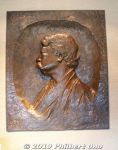
Tenshin Memorial Museum of Art was named after Okakura Tenshin (aka Okakura Kakuzo 1863–1913 岡倉天心/覚三), a famous art scholar and advocate of Japanese art, especially Nihonga paintings.In 1890, he was one of the founders and the first de facto dean of the forerunner of the Tokyo University of the Arts (Geidai), one of Japan's most prominent art universities.
|
|

Lobby of Tenshin Memorial Museum of Art.Tenshin is revered in Kita-Ibaraki because he moved his Nihon Bijutsu-in artist group (Art Institute of Japan) here from Tokyo in 1906. His students, prominent Nihonga painters Yokoyama Taikan (1868–1958), Hishida Shunso (1874–1911), Shimomura Kanzan (1873–1930), and Kimura Buzan (1876–1942) followed him to this picturesque Izura Coast and built artist studio residences near Tenshin's home. The residences of Tenshin, Taikan, and Buzan still remain.
|
|

Tenshin Memorial Room explained the life and achievements of Tenshin. Founded Nihon Bijutsu-in (Art Institute of Japan) and moved it from Tokyo to Izura coast in Kita-Ibaraki in 1906.Includes exhibits about the time he worked at the Boston Museum of Fine Arts in 1910 in charge of the Chinese/Japanese art division.
|
|

Tenshin was proficient in English and wrote the classic book, "The Book of Tea" in English.
|
|

Movie poster for the movie, "Tenshin." It was being screened in the city.
|
|

The museum has fine views of the ocean and southern coast of Fukushima (Iwaki). You may also notice a power plant in the distance. That's not the one that had a meltdown in 2011. It's the Nakoso Power Plant (勿来発電所), a thermal power plant (non-nuclear) operated by Joban Joint Power Co., Ltd.
|
|

Hina Matsuri dolls displayed at the museum entrance.
|
|

Marsala restaurant near the Izura Coast. マルサーラ
|
|

Marsala restaurant has Hawaiian decor.
|
|

Marsala restaurant has Hawaiian decor, but no Hawaiian food. Only tropical drnks in summer.
|
|

Appetizers. The food is good though.
|
|
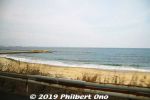
Kita-Ibaraki also has flat, sandy beaches.
|
|

A sea wall being built. After 8 years, we hardly saw any other remnants of tsunami or quake damage.
|
|
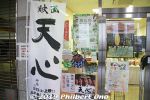
Tourist information center at JR Isohara Station.
|
|

At JR Isohara Station, our tokkyu express train back to Ueno, Tokyo.
|
|

Near Rokkakudo Pavilion on the Izura coast is Itsuura Kanko Hotel (五浦観光ホテル), pictured here on the cliffs. This was our hotel for the night. It had prime views of the coast.The hotel was high enough on the cliff to escape the five-meter-high tsunami on March 11, 2011. The hotel suffered only minor damage from the earthquake. The ground is very solid here, so quake damage was minimal.
Note that the hotel's name is pronounced "Itsuura" while the coast is "Izura." (Kanji characters are the same.) izura.net
|
|

In the hotel lobby: Kita-Ibaraki's official mascots, An-chan and Kou-chan. Together, they are "Ankou" which means "monkfish," or angler fish that is the city's most famous delicacy. An-chan is a fisherman, and Kou-chan is a monkfish.
|
|

In the hotel lobby, Hina Matsuri dolls displayed for Girl's Day in early March.
|
|
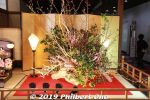
Lovely flowers in the hotel lobby.
|
|

We arrived in the late afternoon in time for a tea ceremony in the hotel lobby. Conducted by the hotel's okami-san (proprietress 女将).
|
|

My complimentary matcha tea and confections.
|
|

Itsuura Kanko Hotel's okami-san or proprietress (女将) speaks English. The hotel also has English-speaking staff.
|
|

Itsuura Kanko Hotel is quite unique and historical because it renovated the artist residences of Nihonga painters Yokoyama Taikan and Kimura Buzan and uses them as part of the hotel where guests can stay. We actually stayed in the Yokoyama Taikan residence here. (横山大観記念館 特別室)
|
|

Entrance foyer of Yokoyama Taikan Memorial Hall where we stayed. Great private lodging for groups up to 22 people.
|
|

Statue of Yokoyama Taikan (横山大観), a very famous Japanese Nihonga painter. Taikan was born in Mito, the capital of Ibaraki. (横山大観)
|
|
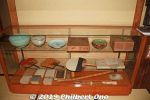
Yokoyama Taikan (1868–1958) is one of the most famous Nihonga painters. His former residence includes a showcase of his artifacts.
|
|

Main corridor inside Yokoyama Taikan Memorial Hall.
|
|
|
|

This used to be part of Yokoyama Taikan's living room, now one of the rooms where you can stay.
|
|

Another room of the living room.
|
|

Outside the living room, a moon-viewing deck.
|
|
|
|